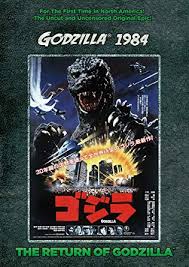
Three months after a volcanic eruption on Daikoku Island in the southern tip of the Izu Islands, the Japanese fishing vessel Yahata-Maru is attacked by a giant monster. After the storm, reporter Goro Maki (Ken Tanaka) is sailing in those same waters. He finds the Yahata-Maru floating aimlessly and boards her. He finds everyone dead except for one lone survivor, Hiroshi Okumura (Shin Takuma). Hiroshi is virtually comatose. Goro is then attacked by a giant sea louse. He is saved by Hiroshi.
Back in Tokyo, Hiroshi identifies the monster that attacked them as Godzilla. Apparently the sea louse are a result of feeding on Godzilla’s radioactive blood and whatever else sea louse eat. Not wanting to cause a panic the Japanese government issues a news blackout. Goro is not permitted to write his story. Looking for more information on Godzilla Goro visits an expert on the monster, Professor Hayashida (Yosuke Natsuki). While Goro is visiting the professor he sees the woman whose picture was in Hiroshi’s wallet. She turns out to be his sister Naoko (Yasuko Sawaguchi). Goro tells her that her brother is alive and being kept incommunicado at the police hospital. She immediately goes to the hospital to find him.
In the meantime a Soviet submarine in the Pacific is destroyed by Godzilla. The Soviets blame the Americans. The Americans deny the accusation. When a surveillance plane gets a picture of Godzilla at the scene the Japanese know they can no longer keep the existence of Godzilla under wraps. To relieve world tensions they release the information about the Yahata-Maru and the survivor Hiroshi. The world is now on alert for Godzilla.
“The Return of Godzilla” was released in 1984 in Japan. In the US it was called “Godzilla 1985” and released in 1985. The film was directed by Koji Hashimoto and R.J. Kizer. Footage from previous films was directed by Ishiro Honda. Produced by TOHO it is the 16the film in the Godzilla franchise and is the first film in the Heisei period. The special effects were directed by Teruyoshi Nakano.
This is the new and improved Godzilla. Returning to Godzilla’s roots it is darker and is considered a sequel to the original 1954 movie. The explosions were really great and they came fast and furious. The Godzilla franchise is recognized by the Guinness World Records as being the longest continuously running movie franchise.
The US version was heavily re-edited and added scenes with actor Raymond Burr reprising his role as Steve Martin from “Godzilla King of the Monsters” 1956. Burr’s scenes were all filmed in one day. The scenes with the actors he is talking to were filmed the next day. The American filming was completed in three days. One of the most controversial changes concerned the Soviet Colonel Kashirin. In the American version he launches the nuclear missile instead of trying to stop it. Director R. J. Kizer later attributed this change to New World Pictures management. The company’s conservative leanings meant that Godzilla was used to make a political statement other than what was intended. Shame on New World. The American version also has scenes moved around, shortened, or deleted. Despite the added scenes the American version is about 16 minutes shorter than the Japanese version.
The American version also has a bunch of product placements. Dr. Pepper for one. Apparently Godzilla also graced a couple commercials for the company. Dr Pepper's marketing director wanted Raymond Burr to “be a pepper too”. At one point they insisted that he drink one during a scene. When Kizer approached Burr on the subject he responded by "[fixing] me with one of those withering glares and just said nothing." Burr’s performance is about the only thing in the American version that isn’t dumb. He delivers his lines seriously and soberly.
There is also an International dubbed version that mirrors more the Japanese version. The dubbing for the International version is a little different than the American version dubbing. The actors doing the dubbing are different actors and the selection of words and phrases used are more colloquial in the American version. Also the Russians in the American version are speaking Russian with subtitles. The American dubbed version verses the International dubbed version shows that the American version is, in a word, campier, or in a better word, stupider.
English dubbed
Japanese subtitled

